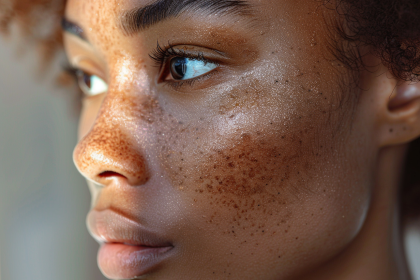Vitiligo, a skin condition affecting millions worldwide, manifests as patches of skin losing their pigmentation. These areas become more sensitive to sun exposure, as the protective melanin is absent. This makes sunscreen a crucial part of daily care for individuals with vitiligo. Understanding the relationship between vitiligo and sun protection can help manage the condition and protect the skin from further damage.
Sunscreen isn’t just for beach days or sunny afternoons; it’s essential for everyone, especially those with vitiligo. Here we will explore how sunscreen plays a critical role in managing vitiligo, what you should know about choosing the right one, and how to protect your skin while maintaining a healthy routine.
What is vitiligo, and why is sun protection important?
Vitiligo occurs when the body’s immune system attacks the pigment-producing cells in the skin, known as melanocytes. As a result, white patches appear on various parts of the body, making these areas more vulnerable to ultraviolet (UV) radiation. Melanin, which provides color to the skin, hair, and eyes, also acts as a shield against the sun’s harmful rays. Without this natural defense, the depigmented areas are at risk of sunburn and long-term skin damage.
The importance of sunscreen for individuals with vitiligo cannot be overstated. Not only does it prevent sunburn, but it also reduces the risk of skin cancer, which is heightened in areas lacking melanin. Additionally, consistent use of sunscreen can help minimize the contrast between depigmented and normal skin, creating a more uniform appearance and potentially boosting confidence in those affected by the condition.
Choosing the right sunscreen for vitiligo
When selecting a sunscreen, individuals with vitiligo should focus on certain features that ensure optimal protection. Here are key factors to consider:
- Broad-spectrum protection Always choose a sunscreen that offers broad-spectrum protection. This means it will shield your skin from both UVA and UVB rays. UVB rays are responsible for sunburns, while UVA rays contribute to skin aging and can penetrate deeper into the skin, exacerbating the damage to areas affected by vitiligo.
- SPF 30 or higher Sun protection factor (SPF) is crucial in determining how long sunscreen will protect your skin. For people with vitiligo, dermatologists recommend using a sunscreen with SPF 30 or higher. This level provides sufficient protection for extended outdoor exposure, reducing the risk of burning the more sensitive depigmented skin.
- Physical vs. chemical sunscreens Physical (mineral) sunscreens contain active ingredients like zinc oxide and titanium dioxide that sit on top of the skin and reflect UV rays. These are ideal for sensitive skin, making them a popular choice for individuals with vitiligo. Chemical sunscreens, on the other hand, absorb UV rays before they can harm the skin. While both types are effective, physical sunscreens are generally better tolerated by those with sensitive skin conditions like vitiligo.
- Hypoallergenic and fragrance-free: The skin affected by vitiligo is often more delicate and prone to irritation. It’s essential to choose hypoallergenic, fragrance-free sunscreen formulas to avoid reactions. Look for products labeled “non-comedogenic” and “dermatologist-tested” to ensure the sunscreen is gentle on your skin.
Daily sun protection routine for vitiligo
Incorporating sunscreen into your daily routine is vital for managing vitiligo. Here’s how to seamlessly include it in your everyday skincare regimen:
- Start with a clean slate: Before applying sunscreen, ensure your skin is clean and free from sweat, oil, or any product residue. This allows the sunscreen to form a protective layer without interference.
- Apply generously: A common mistake many people make is not applying enough sunscreen. To achieve full protection, use approximately a teaspoon of sunscreen for your face and a shot glass worth for your body. Be sure to cover all exposed areas, especially the depigmented patches.
- Don’t forget reapplication: Sunscreen needs to be reapplied every two hours when outdoors, especially if you’re sweating or swimming. If you’re indoors but near windows where UV rays can filter through, reapplying every four to six hours is still important.
- Use sun-protective clothing: For added protection, consider wearing sun-protective clothing such as wide-brimmed hats, sunglasses, and long sleeves when spending extended periods outdoors. Many brands now offer clothing with built-in UV protection, offering an extra layer of defense for your skin.
Emotional impact of vitiligo
Living with vitiligo can come with emotional challenges. The visible nature of the condition often affects self-esteem, especially when societal beauty standards place emphasis on uniform skin tones. However, building a solid skincare routine, including proper sun protection, can empower individuals to regain control over their skin and feel more confident in their appearance.
Knowing that your skin is protected from further damage can reduce anxiety about sun exposure and help individuals with vitiligo embrace outdoor activities without fear. Moreover, the right sunscreen can help even out skin tone, as sun damage often exaggerates the appearance of vitiligo patches, making them more noticeable. Protecting your skin gives you the freedom to enjoy life fully, knowing that you’re taking proactive steps to care for yourself.
Myths about sunscreen and vitiligo
Several misconceptions surround the use of sunscreen for those with vitiligo. Let’s debunk some of these myths to ensure you’re getting the most out of your sun protection routine:
- Myth — sunscreen can reverse vitiligo: While sunscreen is essential for protecting your skin, it cannot reverse or cure vitiligo. Its primary function is to prevent further sun damage and protect sensitive areas from burning.
- Myth — sunscreen isn’t necessary on cloudy days: UV rays can penetrate clouds, making sunscreen necessary even on overcast days. Individuals with vitiligo should apply sunscreen regardless of the weather to ensure consistent protection.
- Myth — higher SPF means you don’t need to reapply: Even sunscreens with SPF 50+ need to be reapplied every two hours. A higher SPF provides more extended protection, but it doesn’t eliminate the need for reapplication, especially after sweating or swimming.
The role of sunscreen in long-term vitiligo management
Sunscreen isn’t just a temporary fix; it’s a long-term solution for protecting the skin and preventing complications associated with vitiligo. As vitiligo is a chronic condition, daily sun protection becomes a lifelong necessity. Over time, consistent use of sunscreen helps maintain a more even skin tone and prevents the worsening of depigmented areas.
Additionally, it reduces the risk of developing skin cancers in vulnerable areas, which is crucial for maintaining overall skin health. By making sunscreen a regular part of your skincare routine, you’re not just protecting yourself from the sun’s immediate dangers — you’re also investing in your long-term health.
This story was created using AI technology.

















